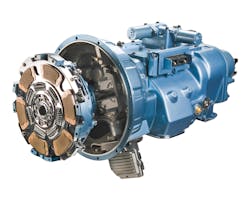The latest confidence report released by the North American Council for Freight Efficiency (NACFE) analyzes the potential benefits automated manual transmissions (AMTs) offer fleets, starting with what the group calls a “conservative” fuel saving estimate of 1% to 3%.
Mike Roeth, NACFE’s executive director, noted that 1%-3% range is “conservative” because the electronic platform AMTs are built upon “opens the door” to other potential fuel savings as the transmission is integrated with the truck’s engine, axles, and other systems.
“One challenging point in our analysis is to look at the benefits AMTs by themselves,” he told Fleet Owner. “What we’re finding is that AMTs are many times an ‘enabler’ for greater fuel savings as they are integrated with the truck’s other systems. It’s like buying a smartphone to get better cell phone capability and then realizing it can do a lot more like surf the web, access email, etc.”
In truck operation terms, such “enabling” benefits include improved “down-speeding” capability, topographical-based shifting, and a more finely-tuned ability to “coast” vehicles down the road using minimal fuel without the need for more shifting-intensive work on the part of drivers.
“Remember, too, when you have an electronic [transmission] platform in place, its capabilities can be improved via software updates rather than physical component changes,” Roeth emphasized. “Thus an AMT can open the door to potential future fuel savings as well.”
NACFE’s report determined that the upfront cost of AMTs is anywhere from $3,000 to $5,000 more compared to manual transmissions, yet the 3% top end fuel economy improvement from AMTs should deliver $2,300 in savings per year per truck with fuel costs pegged at 65 cents per mile with an average 120,000 miles driven per year.
Roeth added that NACFE’s transmission confidence report analyzed the fuel savings value of AMTs placed into both long-haul and regional tractor-trailer service.
He noted that fleets in long-haul on-highway operations using AMTs typically obtain fuel savings at the lowest end of the scale (1%) as such operations typically involve far less shifting that regional operations in more congested urban locales.
“The more shifting that’s needed, the more fuel savings AMTs will generate for the fleet,” Roeth stressed. “That’s also why you now see far more automatics and AMTs in medium-duty trucks working in urban environments.”
He pointed out that not enough data currently exists on automatic transmission usage in tractor-trailer operations for NACFE to make a “conclusive” fuel economy benefit calculation, though he did say the fuel savings potential “looks promising” where automatics are concerned.
NACFE also found that actual fuel savings obtained via AMTs will vary depending on duty cycle, the capability of the driver, and how well the driver has been trained to operate a truck with an electronically controlled transmission.
Yet the group’s research concluded that AMTs can offer overall gains to a fleet by in part reducing the variability in fuel economy that occurs from one driver to the next using manuals, thereby reducing some uncertainty in operating costs.
Roeth also stressed that NACFE’s interviews with fleets indicate significant indirect cost saving benefits from AMTs when it comes to truck drivers such as: lowering driver training costs, improving driver retention rates, and widening the pool of potential truck driver candidates.
“We think those factors, combined with the greater reliability of today’s AMT designs, could make 2014 and 2015 the ‘tipping point’ when the majority of tractor-trailer transmission specs are AMTs versus manuals,” he said.
About the Author
Sean Kilcarr
Editor in Chief
Sean Kilcarr is a former longtime FleetOwner senior editor who wrote for the publication from 2000 to 2018. He served as editor-in-chief from 2017 to 2018.
